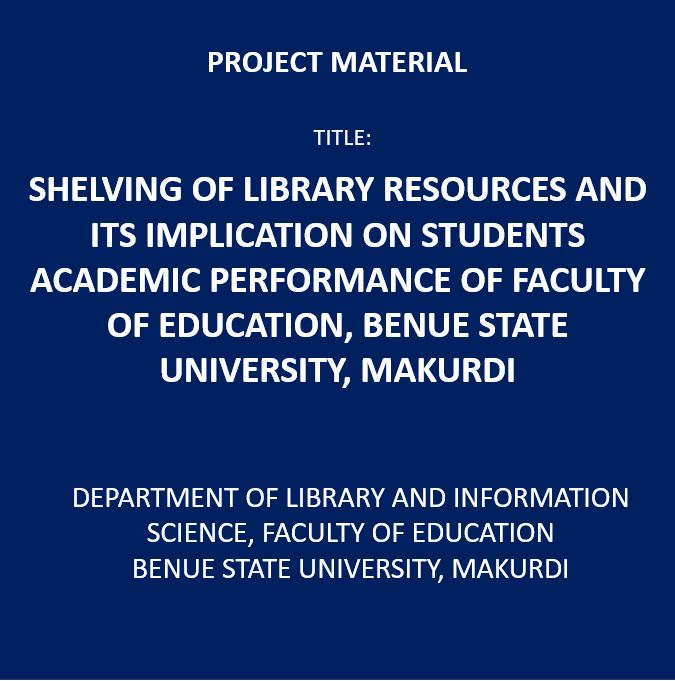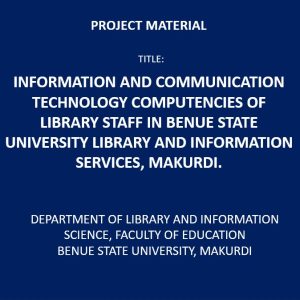No products in the cart.
Shelving of Library Resources and its Implication on Students Academic Performance
₦10,150.00
SHELVING OF LIBRARY RESOURCES AND ITS IMPLICATION ON STUDENTS ACADEMIC PERFORMANCE
- CASE STUDY: FACULTY OF EDUCATION, BENUE STATE UNIVERSITY, MAKURDI
- PROJECT YEAR: 2021
- NUMBER OF PAGES: 55
- FILE TYPE: DOC
- DEGREE: BACHELOR
- INSTITUTE: DEPARTMENT OF LIBRARY AND INFORMATION SCIENCE, FACULTY OF EDUCATION BENUE STATE UNIVERSITY, MAKURDI
Background to the Study
Academic libraries are the ones established and maintained by higher institutions of learning such as universities, polytechnics, colleges of education, schools of nursing, petroleum training institutes and schools of health technology. The essence of establishing an academic library is to enable it support the curriculum of the tertiary institutions which established it (Uwaifo, 2010). They are essential part of the learning community. It is a central service or unit of operation set up to provide location of materials and facilities for study, teaching and research carried out in the institution. The main function of an academic library is to serve as an auxiliary to the parent institution in carrying out its objectives. The Library is an important intellectual resource of the academic community, and helps them fulfill the curriculum requirements and to promote studies and research (Rajendran & Rathinasabapathy, 2005). The library caters for the information needs of the community, through the provision of reading materials for the various programmes of the institution (Igbinosa & Idiodi, 2002).
According to Danton (2013), the major obligation of the academic library with respect to its book selection and book collection is to provide the materials which will now and in the future best contribute to the fulfillment of these closely related functions of teaching, conservation and research. Ajibero (2005) opined that the academic library is the “heart” of the institution. He contends that what all academic libraries have in common, virtually regardless of country or history is their basic position, roles, aims and objectives. The reputation of libraries depends highly on the library facilities it offers its clientele in terms of information resources. As information and research resources become more varied, it places a challenge on academic libraries.
Edoka (2000) enumerated objectives of an academic library as follows: to provide information materials required for the academic programmes of the parent institution, provide research information resources in consonance with the needs of faculty and research students, provide information resources for recreation and for personal self-development of users, provide study accommodation in a useful variety of locations, provide protection and security for these materials, co-operate with other libraries at appropriate level for improved information services, and to provide specialized information services to appropriate segments of the wider community. He further stressed that the prime obligation of an academic library is to provide appropriate information resources for study and research to the members of its own institution.
Libraries generally capture, preserve and disseminate information resources of scholarly interest. Majority of academic libraries are being empowered and enriched today by the facilities in it. These resources do not only add value to library services but serve as a motivational instrument to perform their duties effectively. Karl (2014) asserted that a library with well organised facilities encourages the users to locate and borrow physically available resources. This calls for frequent shelving and shelf reading of these materials for the purpose of orderly and easy retrieval.
Karl (2014) further added that shelving is the process of organising books by call numbers and placing in them their location on the library shelves. It is also regarded as the arrangement of books by call numbers. Simisaye (2012) regarded it as a library activity that involved placement of books, documents and other information materials on the appropriate shelves. Such activity need to ascertain position of the materials.
Shelving is described as organizing books by call numbers and placing them in their correct locations on the library shelves; while shelf reading is the process of reading the call numbers on books that are currently on the library shelves and making sure that they are in the proper order. In stressing the importance of these two main tasks in libraries, Onifade, Onifade and Akintol (2010) pointed out that shelving is an important aspect of library work which can determine user satisfaction or frustration as far as locating library materials is concerned. Lyons and Rutherford (2000) on the other hand, noted that shelving is critical to the success of a library’s service delivery strategies. The importance of shelving materials cannot be overemphasized as it is usually considered being important factor influencing location and retrieval of library materials as every user relies on shelve arrangement.
Busayo (2015) posited that shelving remains a daily routine in virtually all libraries inspite of the current state of technology. In order words, libraries still rely on their human resources to put books used by their users back on the shelves. Books shelved promptly and correctly usually boost the image of the library and also create a welcoming environment of good customer service. Hence the importance of shelving and shelf reading cannot be ignored in any library, be it academic or otherwise. Without accurate shelving of books, effective library operation would be impossible for library staff and their patrons.
From the foregoing, it is evident that academic libraries help to accelerate the implementation of educational programmes so that the aims and objectives of education could be achieved (Arinde, 2010; Anyanwu, Oduagwu, Ossai-Onah, & Amaechi, 2013; Lance & Hofschire, 2012; Owata & Iroha, 2013). According to the World Bank (2008), availability of functional academic library provides additional reading opportunities for students, thus improve their knowledge, writing skills, reading skills and clarity of expression. Fakomogbon (2012) opined that since curriculum is dynamic, academic library help to support both students and teachers in school because it keep them abreast of new development in education.
Meanwhile, studies found that library services are significantly related to student’s academic success. For instance, Idris, Orji and Abana (2012) confirmed that provision of library services increased student’s reading habit. He claimed that learners cannot acquire knowledge only through classrooms; they need to consult library materials (including online) to add to what the teacher has taught them. Adeyemi (2010) argued that the student intellectual development is linked to constant use of library resources. Thus, library is meant to fulfil their information needs because it is more convenient for students to borrow reading materials from the library. Furthermore, Vent (2006) found that library information resources are related to leaner’s learning outcome. Farmer (2006) concluded that the importance of library cannot be underestimated; therefore, library contributes immensely to the academic attainment of students in schools.
Moreover, accurate and timely shelving enhances service to patrons and a requisite that is expected in all libraries. Onifade, Onifade and Akintol (2010) opined that many academic libraries in Nigeria are experiencing difficulty shelving their books due to heavy usage and lack of staff. Thus, it is not uncommon to see book shelves disorganised and untidy. Staff attitudes coupled with the boring task of shelving are often cited as reasons behind this problem (Aliero, 2003). Library as espoused by Aina (2004) is to provide materials and services that will now and in the future contribute to the fulfilment of the objectives of the university.
However, in order to improve on the challenges of the shelving staff in the library as well as boast their morale, Onifade, Onifade and Akintol (2010) suggested the following strategies: library management should give adequate training to shelving staff before they assigned to shelves. During the training, the importance of accurate and timely shelving should be emphasized. In addition, the training should also include health care talks because shelving entails repetitive actions which can cause muscle fatigue, strain on the eyes, neck and back. Also, motivation should be put in place as rewarding the most accurate and best shelving staff at the end of the year.
Students of the Faculty of Education seems to have been spending a lot of time in the faculty library especially standing close to the shelves. This could be as a result of difficulty in locating and retrieving needed information on the shelves as a result of improper shelving. This makes students/users not to have access to the information they require or need for exploitation which could either be for examinations, term papers, assignments or research thereby leading to low performances in their academics and discourage many library users from patronizing the library. It is against this backdrop that this study therefore seeks to investigate shelving and its implication on students academic performance among students of Faculty of Education, Benue State University, Makurdi.


